|
신검의 전설 (Sin'geom-ui Jeonseol) - APPLE ][ (October 1987)
|
|
우주전사둘리 (Uju Jeonsa Dooly) - APPLE ][ (April 1988)
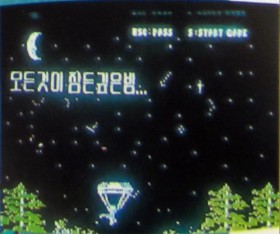
Uju Jeonsa Dooly (Apple II)
|
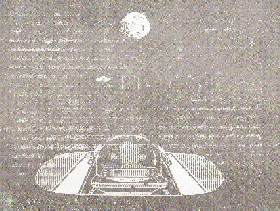
Uju Jeonsa Dooly (Apple II)
|
|

Cover
The first of many games based on the Dooly cartoon series, here the baby dinosaur becomes an astronaut. Set in the far future of 2001, the story about two planets, a wealthy democratic one, and the surpressed world reigned by the evil dictator 'Dragon' is quite elaborate for this type of early arcade style game. Dooly has crashlanded on earth, and has to get back to the planet Kkanttappia.
Uju Jeonsa Dooly is a mixture of many different genres. In the first two stages, Dooly has to catch food and fuel falling from the sky to power is space ship. After that follows a Breakout clone level, before he finally takes off into space, where the minions of Dragon attack for a shooting sequence. Then awaits a puzzle game to get through a black hole, and finally a rush of several bosses.
Sadly, the game hasn't been preserved by now, and it is uncertain whether there are any working copies left. The screenshots are not in the best quality because of this.
|

Uju Jeonsa Dooly (Apple II)
|
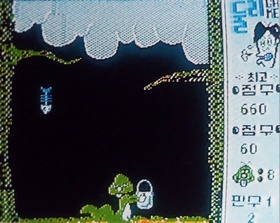
Uju Jeonsa Dooly (Apple II)
|
|
|
|
제3차우주전쟁 (Je 3-cha Uju Jeonjaeng) - MSX (April 1988)

Advertisement Art
|
The title means "Space War 3", but rather than being the 3rd part of a series, the number is to be read like in World War 2. Practically nothing is known about this game. It appeared in an Aprosoft magazine ad and release list, but it is uncertain whether or not it still exists.
|
|
|
꾀돌이 (Kkoedori) / Koedoli - MSX (October 1988)
|
|
미스 애플 (Miss Apple) - APPLE ][ (1989)

Miss Apple (Apple II)
|
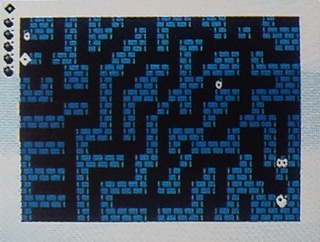
Miss Apple (Apple II)
|
|
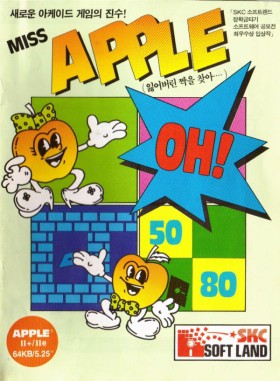
Apple II Cover
Miss Apple was the winning program in a coding competition held by Aproman together with SKC Softland. In 80 stages, Miss Apple has to maneuver through a labyrinth to collect all the apples to reach the next maze.
On the surface the game seems like a Pac-Man clone, but it features a few interesting gameplay systems. Instead of ghosts, Miss Apple is hunted by quarter apples, and if she can trick them into bumping together, the resulting half Apple can be eaten to enable Miss Apple to go through walls for a short time.
This is another game that has not been preserved, yet.
|
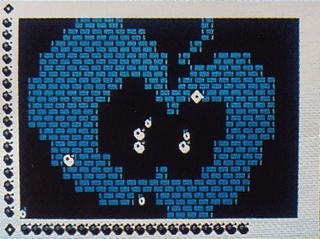
Miss Apple (Apple II)
|
|
|
|
미스 퍼즐 (Miss Puzzle) - Apple ][ (1989)

Miss Puzzle (Apple II)
|
A simple puzzle game for the Apple II, consisting of 6 stages.
|
|
|
띠띠!빵빵! (Tti Tti! Ppang Ppang!) - MSX (1989)

Tti Tti! Ppang Ppang! (MSX)
|
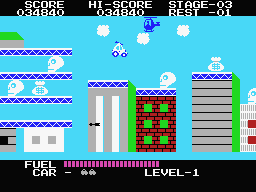
Tti Tti! Ppang Ppang! (MSX)
|
|
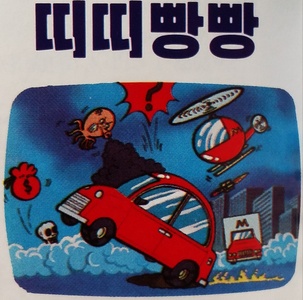
Advertisement Art
|
Programmed by Jang Sungmok, the platformer with the funny name uses graphics from Choro Q and also shares similarities with Jump Bug, but it is a completely different game. The player car constantly drives at high speed and never brakes nor stops, the only ways to maneuver are changing direction and jump. The journey goes over rivers and skyscraper rooftops, an explanation what business a car with a propeller on top has got there is missing. Collision detection is very asinine, and after dying, the game likes to respawn the car just above another deadly gap.
There are three stages, each has its own enemy type in addition to the omnipresent skulls: Construction cars at the beginning, cuttlefish in the second stage, and finally helicopters. After all three stages, the sequence just repeats over and over again.
|
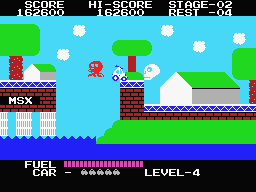
Tti Tti! Ppang Ppang! (MSX)
|
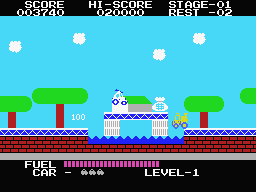
Tti Tti! Ppang Ppang! (MSX)
|
|
|
|
King's Valley / 왕의 계곡 (Wang-ui Gyegok) - PC-DOS (1989)
|
|